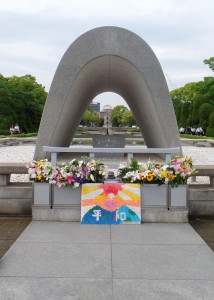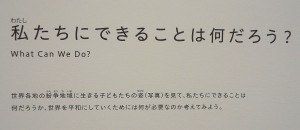“Seeking Peace: Embodying Peace and Justice in Postwar Japan” is part of the Global Connections program at Oxford College. Drs. Jill Petersen Adams and Margaret T. McGehee are co-leaders of the 2015 program. This co-curricular (i.e., non-credit-bearing) experience is meant to provide experiential learning that transgresses the boundaries of the traditional classroom and traditional study abroad in order to focus on issues of social responsibility. The literature for Global Connections describes the program as “a travel experience designed to help students create meaning in their lives and connect their religious and spiritual convictions with justice issues, including peace, poverty, human rights, and the environment. Seminar activities and service experiences that offer reflection and meaningful dialogue with others aim also to help participants become agents of change for healthy living both here and abroad.”

“Seeking Peace” takes place in Japan in 2015, marking the 70th anniversary of the Battle of Okinawa, the bombings of Hiroshima and Nagasaki, and the end of the Pacific War/ World War II. The program builds on this commemorative occasion to provide a focused opportunity to engage the legacies of war and catastrophic loss in religious and secular spheres. Students have the opportunity to confront how “peace” and “justice” are words employed in trying to understand and dialogue with, in trying to act and react to, myriad experiences of catastrophic suffering. In doing so, students also attend to the (political, historical, and religious) precursors to that suffering in Japan as well as its ongoing legacies.
“Peace” (heiwa) was a word employed early, and frequently, in reactions to the Battle of Okinawa and the atomic bombings at individual, local, national, and international levels—by poets and novelists, activists and politicians—and the word took on a multitude of meanings. “Peace” became a rallying cry and site of resistance; a buzzword of nationalist propaganda, an organizing principle of city governance, the foundation of a tourist industry, and the desperate longing of survivors; a word of hope and despair. By engaging survivor accounts and meeting with people affected by the bombings; visiting religious, cultural, and memorial sites; talking to people who preserve loss or hasten for change; debating in seminars and orientation meetings; confronting material remains in museums; examining art and other cultural products; and meeting with Japan-based youth and religious groups; participants question the nature and meanings of peace and justice but also the pull and the power of those words to inspire change. Students realize the care and responsibility that any “agent of change” needs to cultivate if (s)he is to promote the health of persons, environs, and nations.

Project Goals
- An understanding that peace and justice are “floating” signifiers, meaning not that these words carry no meaning(s) but instead that they carry multiple meanings subject to position and politics—i.e., peace and justice are words that designate a desire and a process as much as a telos or goal.
- An appreciation that “memory” is an activity that goes beyond retrieval, that memory is not simply turned toward the past but is actively engaged with concerns about the present and future.
- A cultural sensitivity that will enrich student experiences at the institution by introducing or providing a forum for discussion of non-Western, non-Abrahamic traditions and practices (even if students come from non-Western, non-Abrahamic backgrounds themselves).
- “Defamiliarzation,” to use J.Z. Smith’s adaptation of the idea for religious studies—making the familiar strange, helping students reflect on their “ways of looking,” their ways of being students and proto-scholars, in order to come to more complicated understandings of people, places, and processes (and first of all, their own).
- A sense of the ways that environment, religion, poverty, identity, nationality, sex, gender, embodiment and many other factors affect experiences of and responses to catastrophic suffering.
- An experience with the complicated intersections of cultural, religious, and military history that may allow for a more nuanced understanding of postwar formations not only in Japan but in surrounding East and Southeast Asia and in the United States as well.
- Some understanding of how, therefore, the “atomic bombings of Japan” are not “past” events but instead shape cultural and political lives today—in current discourse about reversing Article 9 of the Japanese constitution (which prohibits war), debates about the use of the Japan Self-Defense Forces, anti-nuclear activism in the wake of the 2011 Fukushima Daiichi nuclear plant meltdown, and ongoing conflicts between Japan and its nearby neighbors, particularly China and Korea.
